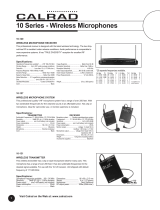
HDMI-G
VIDEO CABLE: HDMI
• Conductive-Coated Conductors
• Critical Twist Geometry
• Skin/Foam/Skin Polyethylene
Why: Other video connection systems (composite, S, component, RGB) transmit an analog signal.
When a digital source (CD, digital cable box, digital video recorder) is connected to a digital display
(LCD, plasma, DLP), the best picture is made possible by transmitting a digital signal.
The HDMI standard was invented to best ensure getting all the data, audio and video, from a
source (maybe through an A/V receiver), to a display with no degradation.
Both the DVI-D and the more recent HDMI transmission standards come from the same “working
group”. Both systems transmit the same uncompressed digital video signal. The only two differ-
ences you must know:
1) The connectors are different.
2) HDMI inputs and outputs are capable of digital audio; DVI is video only.
How: AudioQuest HDMI-G uses large Conductive-Coated conductors. Skin/Foam/Skin Polyethyl-
ene (PE) is used to minimize loss caused by insulation, and to insure critical geometry stability.
HDMI is available in lengths of 1M, 2M and 3M and is also available in an off-white PVC CL-3 rated
jacket in various lengths from 3M to 12M.
HDMI-G
DVI-IN > HDMI-OUT
F-DVI to M-HDMI
HDMI-IN > DV I-O UT
F-HDMI to M-DVI
Female HDMI jack to male DVI-D plug.
Allows HDMI cable to be used with
equipment fitted with DVI-D jack(s).
Female DVI-D jack to male HDMI plug.
Allows DVI-D cable to be used with
equipment fitted with HDMI jack(s).
-
 1
1
AudioQuest HDMIG1M Datasheet
- Category
- HDMI cables
- Type
- Datasheet
Ask a question and I''ll find the answer in the document
Finding information in a document is now easier with AI
Related papers
Other documents
-
 Kimber Kable Music Harmony with Science PowerKordsTM User manual
Kimber Kable Music Harmony with Science PowerKordsTM User manual
-
Kramer Electronics C-HDMI/DVI-10 Datasheet
-
 Calrad Electronics 40-998-HS Datasheet
Calrad Electronics 40-998-HS Datasheet
-
G&BL HVQ3 User manual
-
König CMP-USBVG5 Datasheet
-
Digitus AK-117016 Datasheet
-
Atlona AT-LC-1.5 User manual
-
Gefen CAB-HDMIX-100MM Datasheet
-
ATEN VE806 User manual
-
ATEN VE157 User manual


